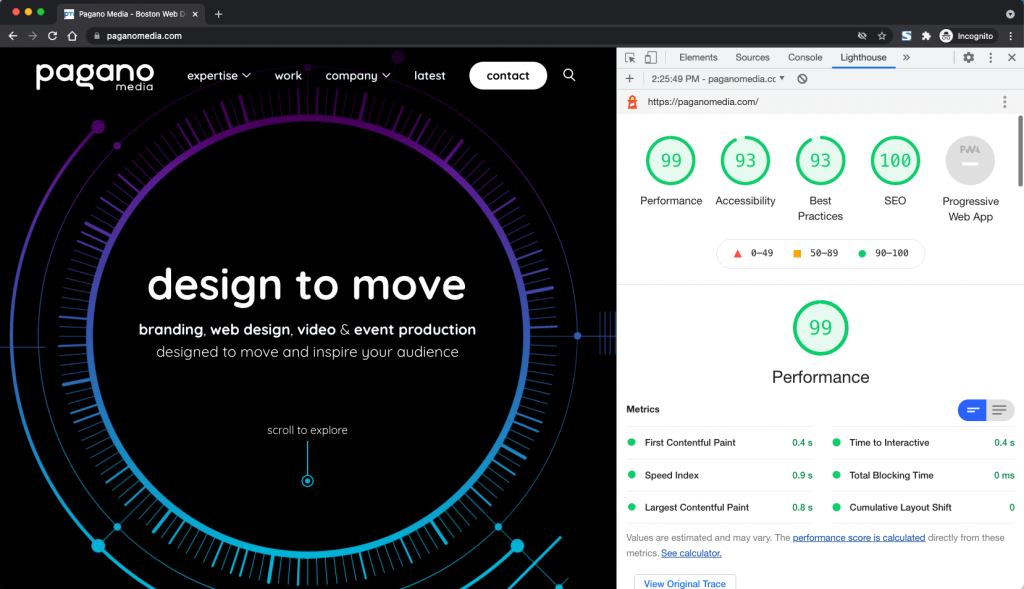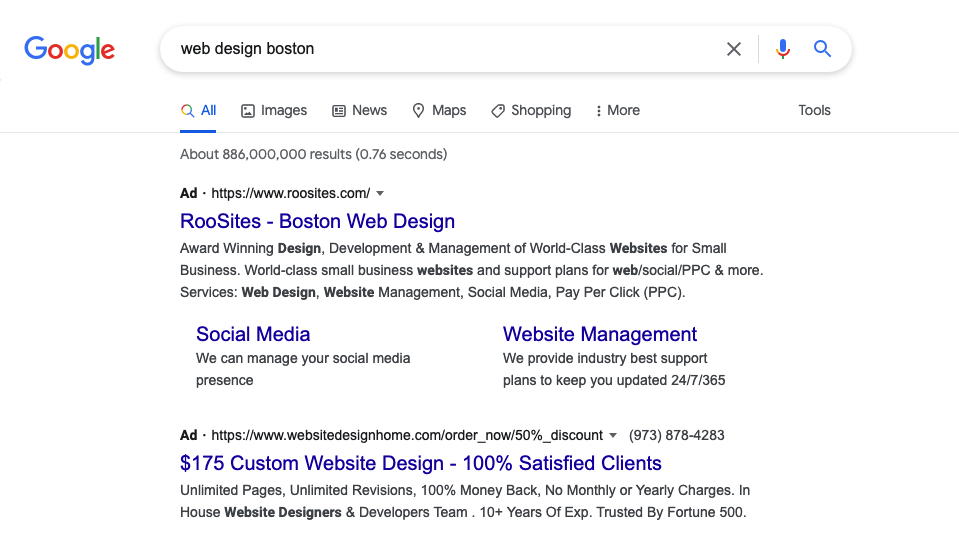How To Improve Your Google Search Results Ranking

It’s like trying to get to the front row of a concert. You nudge, swerve, and push, but the effort always seems futile. Making it on the first page of Google is a similar experience. It’s hard to achieve, but a worthy investment for growing your business. Click-through rates drop dramatically after the first page of search results.
Here are a few options to improve your Google search ranking:
- A website redesign that improves the user experience (UX).
- Enhance SEO best practices on your website.
- Develop a Google Ads strategy to acquire one of the four ad slots at the top of the first page of Google results.
These three options are not mutually exclusive, but which option should you pursue first? The first step in answering this question is a website audit.
Performing a Website Audit
A primary focus of Google’s search algorithm is Google Page Experience, which measures your site’s page load time, mobile-friendly design, HTTPS security, and core web vitals. All of these factors contribute to a good user-experience, so it’s important to have high scores. Low scores on these metrics negatively impact your search ranking.
Use PageSpeed Insights to measure and find ways to improve your site’s page speed. Use Lighthouse to measure and find ways to improve other areas relating to core web vitals, such as performance, accessibility, best practices, and SEO.

In addition to checking your core web vitals, you should check your Google Analytics account for things like bounce rate and engagement.
Improve UX Through a Redesign
Having poor web vitals can explain low performance in bounce rate and user engagement, but if your web vitals are healthy and you still have a high bounce rate and low engagement, this can be an indication that your website design and content need to be refreshed, in which case, option 1—a website redesign—is the ideal next step.
Be sure to find an agency that is strong in design, core web vitals optimization, and SEO to maximize your impact in ranking higher on Google’s search results.
Enhance Your SEO
If your website scores well on the aforementioned performance metrics, or if redoing your website is cost prohibitive, focus on option 2—enhancing SEO on your existing website. There are four baseline SEO best practices that your website should be following to improve your Google search ranking:
#1
Identify relevant search terms and keywords using the Google Keyword Planner. Find keywords that have high search volume and low competition so that your website has a better chance at a top spot on the search page when those keywords are searched.
#2
Integrate your search terms and keywords into the copy of your website text at a natural cadence. Keyword-rich websites are great for SEO, but search engines now penalize sites for “keyword stuffing” – meaning a haphazard use of keywords for the sole purpose of trying to rank better in search results. This is an outdated SEO practice that is bad for the user and now hurts your Google ranking. Take the time to naturally align your copy with your SEO terms.
#3
Write keyword-rich copy for your image alt-text and meta descriptions. Make sure the images on your website have strong alt text. This will help people with visual impairments understand what the image is, which will also help your ranking since Google factors in accessibility. Additionally, this is a chance to add keywords that naturally contain or align with your primary keywords, as Google uses the alt description to properly list them in Google image searches. Be sure the alt description, first and foremost, is relevant to the image so it doesn’t confuse people with visual impairments.
#4
Integrate video into your site. Not only does video provide a more engaging and dynamic experience with your website, but it is also great for SEO. Google owns YouTube, and relevant videos will appear in search results as a result.
Instant Traffic Boost with Google Ads

The key to implementing a successful Google Ads strategy is two-fold: know your goals and do your research.
Here are 6 tips for putting together a Google Ads strategy that will boost your search rankings and drive meaningful traffic to your website:
#1
Paid advertising is exactly that – an investment – therefore it’s important to know why you’re doing it and what you want to get out of it. Google will ask you what you want to achieve with your Google Ads. Do you want to grow sales, acquire new customers, increase website traffic, promote a service or product, or boost brand awareness? These are examples of growth goals that Google Ads can help you achieve.
#2
Research your current customer base and target customers. Do a deep dive into your customer experience. What are your customers saying about you through Google reviews and other review boards? What is some other feedback you are getting from the marketplace about your products and services? Where, when and why are they favoring competitors? What are their unmet needs? In terms of acquiring new customers, research what your competitors do well. How can you offer an experience that exceeds their expectations and beats your competition?
#3
Once you have a deep and up-to-date understanding of your goals and customers, it’s time for keyword research. This is the foundation of your campaign and determines how you rank in search results. Choosing the right keywords requires more research. We recommend starting with tools like Google Search Console and BuzzSumo to analyze how people are searching certain topics and how your competitors’ content is ranking for those search results. Focus on 5-10 keywords that are relevant to a specific topics. You will ultimately add all these keywords to your Google Ads campaign as Exact Match Keywords, which ensures that your ads show up for the most relevant search queries.
#4
Put your keywords into Ad Groups and segment the traffic based on demographics. Google Ad Manager will allow you to arrange your keywords into Ad Groups in order to support your customers’ searches in a relevant way based on where they are in their buyer’s journey. Your current and prospective audiences are either looking to learn more or buy, therefore it’s important to group your keywords into highly-related ad groups based on their intentions. Lastly, traffic is not uniform. Your audience varies based on location, device, and other demographics. It’s important to segment your Google Ad campaigns based on those variables by providing tailored landing pages, budgets, and keywords.
#5
Write punchy, eye-catching ad copy. Your ad copy needs to draw the eye and intrigue the mind. Not only should the copy use your exact keywords, but it needs to stand out from competitors in a meaningful way. People are ad-weary – only the best written ones will catch peoples’ attention.
#6
Track performance & analyze the data. Google Ad Manager has robust analytics and metrics reporting capabilities. Be sure to track engagements like downloads, click-through rates, phone calls, and other conversions. To really get the biggest bang for your buck, use the data to figure out which keywords, messages, and offers are working and which ones should be tweaked. Using these insights strategically is what generates the highest return on your Google Ads investment.
Use these tips to evaluate your current SEO challenges and determine which strategy is the best option for your business.
Need help getting on the first page of Google?
Reach out to Kate to evaluate your SEO practices and improve your search results.